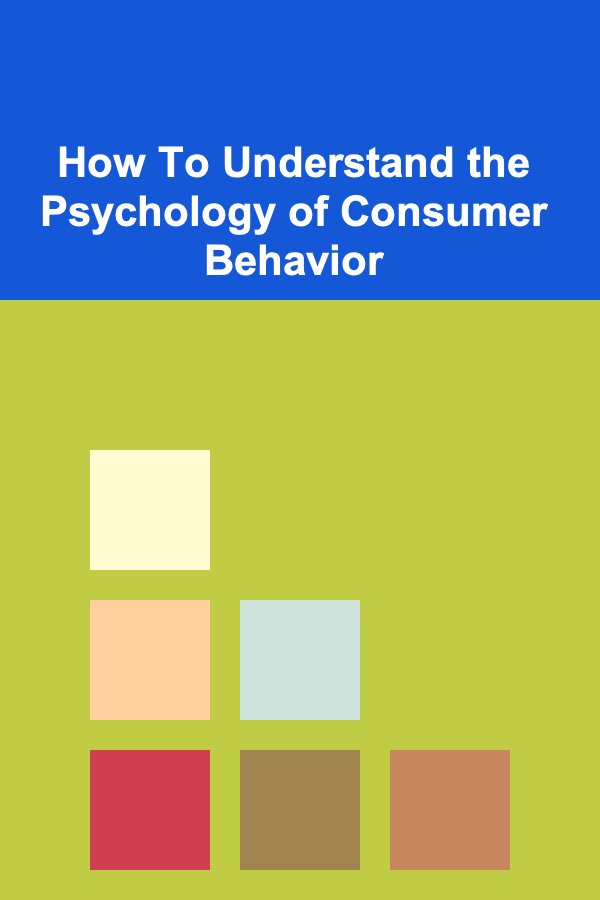
How To Understand the Psychology of Consumer Behavior
ebook include PDF & Audio bundle (Micro Guide)
$12.99$6.99
Limited Time Offer! Order within the next:

Understanding consumer behavior is fundamental for businesses, marketers, and entrepreneurs. The decisions made by consumers when purchasing goods and services are often influenced by a wide range of psychological factors. From emotions to social influences, from cognitive biases to individual preferences, understanding these dynamics is critical for any business aiming to attract, retain, and satisfy customers. In this article, we will delve into the psychology of consumer behavior, exploring the various elements that shape how consumers make decisions and how businesses can use these insights to improve their strategies.
The Basics of Consumer Behavior
Consumer behavior refers to the actions and decisions of individuals or groups when purchasing, using, or disposing of products or services. It involves understanding the reasons behind why consumers choose one product over another, how they make decisions, and what factors influence these decisions. The psychology behind consumer behavior is multifaceted and influenced by both internal and external factors.
The internal factors include:
- Cognitive processes: The way individuals think, perceive, and interpret information about products and services.
- Emotions: How feelings such as fear, joy, or excitement can influence buying decisions.
- Motivations: The needs and desires that drive people to make purchasing decisions.
The external factors include:
- Social influences: The impact of family, friends, culture, and society on consumer choices.
- Marketing stimuli: How advertising, pricing, and product placement influence consumer choices.
- Economic factors: The overall economic environment, including income levels, economic stability, and consumer confidence.
By understanding both internal and external influences, businesses can tailor their marketing strategies to meet consumer needs more effectively.
The Role of Emotions in Consumer Decision-Making
Emotions play a pivotal role in consumer behavior. While traditional economic models often assume that consumers make rational decisions based on objective analysis, research shows that emotions are just as significant in shaping consumer choices. In fact, emotional responses can sometimes outweigh logical reasoning in the decision-making process.
Emotional Triggers in Consumer Behavior
Emotional triggers are often used by brands to elicit specific feelings from their consumers. These emotions can include:
- Fear: Fear is a powerful motivator. Brands often use fear-based marketing tactics to promote urgency or scarcity. For example, phrases like "limited-time offer" or "only a few left" can trigger fear of missing out (FOMO) and encourage immediate purchase.
- Happiness: Brands use positive emotions, such as happiness, to associate their products with feelings of joy and satisfaction. This is often seen in the use of vibrant visuals and happy music in advertisements.
- Trust: Building trust is essential for long-term consumer loyalty. Brands that evoke trust through consistent quality, transparency, and excellent customer service tend to foster more enduring relationships with consumers.
- Nostalgia: Marketers often use nostalgia as an emotional tool, evoking feelings of warmth and comfort. Many ads use nostalgic imagery, music, or messaging to connect with consumers on a deeper emotional level.
The Emotional vs. Rational Decision-Making
While emotions play a major role in consumer behavior, they are often intertwined with rational thinking. For instance, a consumer may feel emotionally connected to a particular brand, but they will also consider logical factors such as price, quality, and functionality before making a purchase.
The balance between emotional and rational decision-making varies by individual and situation. Some purchases, such as luxury goods, may be driven more by emotions like status and self-expression, while others, such as basic necessities, are more likely to be driven by rational considerations.
Motivation and Consumer Needs
Motivation is a key psychological factor in consumer behavior. Theories such as Maslow's Hierarchy of Needs provide a framework for understanding how human needs and desires influence behavior.
Maslow's Hierarchy of Needs
Maslow's Hierarchy of Needs is often used to explain consumer motivations. According to Maslow, people are motivated by different levels of needs, starting with basic physiological needs and progressing to self-actualization.
- Physiological Needs: These are basic survival needs such as food, water, shelter, and clothing. Consumers motivated by these needs are likely to prioritize essential goods and services.
- Safety Needs: Consumers are motivated to seek safety, stability, and protection. This can lead to a demand for insurance, home security systems, and healthcare services.
- Social Needs: Humans have a desire for social connection, belonging, and acceptance. This can drive purchases related to social interactions, such as fashion, social media platforms, and entertainment.
- Esteem Needs: Consumers seek recognition, respect, and status. This drives the demand for luxury goods, brand-name products, and items that signify social status.
- Self-Actualization: At the highest level, self-actualization refers to personal growth and fulfillment. Consumers motivated by self-actualization may seek products and services that promote creativity, learning, and self-improvement.
The Role of Intrinsic vs. Extrinsic Motivation
Consumer motivation can also be categorized as intrinsic or extrinsic.
- Intrinsic Motivation: This refers to doing something because it is inherently satisfying. For instance, a person may buy an eco-friendly product because it aligns with their values, not because of any external reward.
- Extrinsic Motivation: This refers to doing something for external rewards or outcomes. For example, consumers may purchase products to gain social status, receive discounts, or avoid penalties.
Understanding whether a consumer is driven by intrinsic or extrinsic motivations helps businesses tailor their marketing strategies and product offerings to meet the specific needs of their target audience.
Cognitive Biases and Decision-Making
Cognitive biases are systematic errors in thinking that influence decision-making. Consumers are not always rational beings; their decisions can be influenced by these biases, which can lead to inconsistent or irrational choices.
Common Cognitive Biases in Consumer Behavior
- Anchoring Bias: Consumers tend to rely heavily on the first piece of information they receive (the "anchor") when making decisions. For example, if an item is initially priced at $100 and is then discounted to $75, consumers may perceive the $75 price as a better deal, even if the original price was inflated.
- Bandwagon Effect: People tend to follow the crowd, believing that if many others are doing something, it must be the right choice. This is why product reviews, influencer marketing, and viral trends are so powerful in influencing consumer behavior.
- Framing Effect: The way information is presented can significantly affect consumer decisions. For instance, a product described as "90% fat-free" is more likely to be purchased than one labeled "contains 10% fat," even though they are the same product.
- Loss Aversion: Consumers are more motivated to avoid losses than to achieve gains. This is why limited-time offers and discounts framed as "saving" a specific amount of money can be effective in encouraging purchases.
- Endowment Effect: Consumers tend to place more value on things they own, even if they are no longer useful. This bias can influence consumer behavior in the form of brand loyalty and reluctance to switch to a competitor.
Understanding these biases allows businesses to frame their marketing messages and product offerings in ways that align with consumer psychology, increasing the likelihood of a purchase.
Social Influences on Consumer Behavior
Humans are inherently social creatures, and consumer behavior is often influenced by social factors. Consumers are affected by their social environment, including family, friends, and broader societal norms.
Social Proof and Influence
One of the most powerful social influences on consumer behavior is social proof. Social proof refers to the idea that people tend to make decisions based on the actions and opinions of others. When consumers see others buying a product or endorsing a brand, they are more likely to do the same. This is why customer reviews, ratings, and testimonials are so effective in shaping purchasing decisions.
Peer Influence and Social Networks
Peer influence plays a significant role in consumer behavior. People tend to trust recommendations from friends and family more than advertisements or sales pitches. This is why word-of-mouth marketing and influencer endorsements are so powerful. Social media platforms, such as Instagram, Twitter, and TikTok, have amplified this effect, allowing consumers to see what their peers are buying and using, which in turn influences their own purchasing decisions.
Cultural and Societal Influences
Cultural factors also have a profound impact on consumer behavior. People's purchasing decisions are often shaped by the values, traditions, and social norms of their culture. For example, in collectivist societies, people may prioritize products that promote social harmony or contribute to the well-being of the group, whereas in individualistic cultures, consumers may prioritize products that emphasize personal achievement and uniqueness.
The Impact of Technology on Consumer Behavior
The rise of digital technology and the internet has dramatically altered consumer behavior. Consumers now have access to a wealth of information and can make informed purchasing decisions in a matter of seconds. The advent of e-commerce, mobile shopping, and social media platforms has reshaped how consumers discover, research, and purchase products.
Online Shopping and Decision-Making
The ease of online shopping has made consumers more discerning and selective. With access to product reviews, comparison websites, and social media influencers, consumers can make more informed decisions. This has also led to an increase in the demand for personalized shopping experiences, as consumers expect brands to cater to their individual preferences.
The Role of Artificial Intelligence in Consumer Behavior
Artificial intelligence (AI) is increasingly being used to personalize marketing and improve the consumer experience. AI-driven algorithms can predict consumer preferences, recommend products, and deliver personalized content in real time. This level of personalization increases the likelihood of conversions and enhances customer satisfaction.
Conclusion
Understanding the psychology of consumer behavior is essential for businesses seeking to connect with their target audience and drive sales. By considering the emotional, cognitive, and social factors that influence consumer decisions, businesses can create more effective marketing strategies, improve product offerings, and build lasting customer relationships. Consumer behavior is complex, but by studying and applying psychological principles, companies can gain a deeper understanding of what drives their customers and how to better serve their needs.

How to Care for Your Pet's Coat and Fur at Home
Read More
How to Develop Resilient Food Systems
Read More
How to Maximize Your Rental Property's Value with Smart Upgrades
Read More
How to Store Your Sports Gear Efficiently in Limited Space
Read More
Scaling Your Deep Learning Projects into Profitable Businesses
Read More
How To Understand Perspective in Drawing
Read MoreOther Products

How to Care for Your Pet's Coat and Fur at Home
Read More
How to Develop Resilient Food Systems
Read More
How to Maximize Your Rental Property's Value with Smart Upgrades
Read More
How to Store Your Sports Gear Efficiently in Limited Space
Read More
Scaling Your Deep Learning Projects into Profitable Businesses
Read More